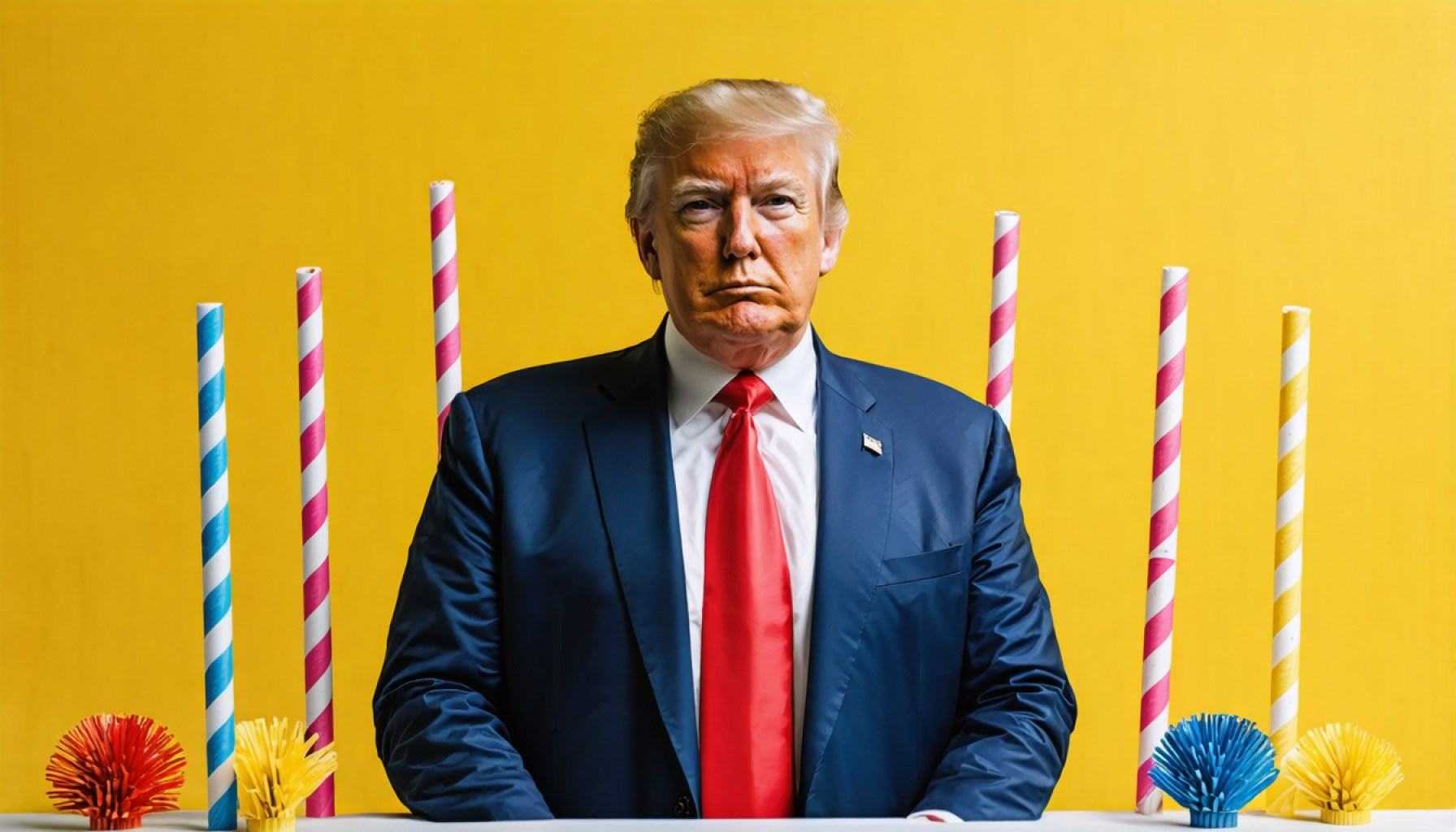- President Donald Trump targets paper straws, citing hygiene, inefficiency, and potential environmental risks, including “forever chemicals” like PFAS.
- The administration pushes the FDA to investigate PFAS in paper straws, emphasizing the chemicals’ environmental persistence.
- Federal cafeterias and future government contracts are shifting away from paper straws in favor of alternatives.
- This move represents a broader ideological debate on balancing environmental goals with practical functionality.
- Democratic states like California and New York continue to enforce strict regulations on single-use plastic, highlighting state-federal tensions.
- The issue prompts a societal reflection on integrating sustainability without sacrificing everyday tool reliability.
A turbulent gust of change sweeps through America’s corridors of power as President Donald Trump sets his sights on a commonplace target: paper straws. Once hailed as the eco-friendly successor to plastic straws, these paper tools of the future are now in the crosshairs of the current administration. With the stroke of a pen in a February executive order, Trump signaled the beginning of the end for paper straws in federal use, alleging they harbor hygienic hazards, inefficiency, and, more controversially, “forever chemicals” detrimental to the environment.
The administration is unlocking every policy lever available. The domestic policy council’s latest report underscores its push for the FDA to probe the risks associated with PFAS in paper straws. These synthetic chemicals, lauded for their water-repelling properties, could potentially persist in the environment indefinitely, posing a significant threat. In the halls of government, the shift is palpable. Federal cafeterias quietly pivot away from paper straws, and future government contracts are poised to exclude them entirely.
Trump is not alone in decrying the thin, often soggy paper alternatives to plastic straws. Critics point out that, unlike their predecessors, paper straws disintegrate almost as quickly as they are immersed in soda or iced coffee, rendering them futile in their fundamental role. Their rise was fueled by a desire to cut back on plastic pollution—a statistic Donald Trump dismisses as fictitious. For him, they exemplify the follies of a previous administration’s policies, now ripe for repeal.
Interestingly, Democratic strongholds such as California and New York, clinging to environmental ideals, continue to uphold stringent regulations on single-use plastic straws. These regulations mandate that plastic straws are only available upon request, reinforcing the schism between state and federal governance. Trump’s new directive seeks to tip the scales back toward plastic, arguing from a position of common sense and practicality, rather than purely environmental optics.
This latest pivot represents more than just a mundane battle of straws; it’s a microcosm of a larger ideological contest about how to balance environmental priorities with practical functionality. As the nation watches, the debate forces citizens and lawmakers alike to confront the complex interplay between innovation for a sustainable future and reliability within everyday tools.
As this paper straw saga unfolds, the key takeaway emerges as a question we must answer: How can we innovate sustainably without compromising on functionality, and what role should government policy play in shaping those choices?
The Straw Debate: What Trump’s Ban on Paper Straws Means for America’s Eco-Future
Background and Context
In a dramatic pivot from previous environmental initiatives, President Donald Trump has targeted paper straws as indicative of failed policy, citing issues such as hygiene risks, inefficiency, and the presence of “forever chemicals” like PFAS, which raise environmental concerns. This policy shift resonates throughout federal establishments, with a notable transition away from paper back to plastic. But what are the broader implications of this change, and how does it reflect on America’s sustainability efforts?
PFAS: Understanding the Controversy
Per- and polyfluoroalkyl substances (PFAS) are often used in paper-based products for their water-resistant properties. However, PFAS have been linked to environmental persistence, earning them the moniker “forever chemicals.” The FDA’s investigation into their safety reflects growing worries over public health and ecological implications.
– Health Concerns: PFAS have been associated with various health issues, including hormone disruption and increased cancer risk, according to studies by the Environmental Working Group (EWG).
– Environmental Impact: Due to their durability, PFAS can accumulate in water bodies and soil, leading to widespread ecological disruptions.
Rising Trends in Sustainable Alternatives
Despite the criticism of paper straws, industry trends reveal ongoing innovation in creating sustainable consumer products. Alternatives like metal, bamboo, and silicone straws offer compelling advantages:
– Durability and Reusability: Unlike disposable options, these materials provide extended usability, reducing the need for frequent replacements.
– Biodegradability: Bamboo straws, in particular, decompose naturally, aligning with environmental sustainability goals.
State vs. Federal Regulations
The divide between state and federal policies on straw usage illustrates a broader conversation on governance and environmental responsibility:
– State-Level Measures: States like California have enacted regulations requiring plastic straws only be available upon request, emphasizing reduction in plastic waste.
– Federal Stance: The new executive order exemplifies a shift toward practical concerns, gravitating back to plastics for cost-effectiveness and functionality.
Potential Risks and Industry Reactions
The movement against paper straws could have wide-ranging impacts:
– Market Adjustments: Businesses may need to reassess product offerings to align with changing policies and consumer expectations.
– Cultural Shifts: This policy could affect the growing culture of sustainability, prompting further discussion on balanced environmentalism.
Real-World Impact: How Can You Adapt?
1. Support Local Legislation: Engage in community discussions and advocate for localized regulations that continue promoting sustainable alternatives.
2. Embrace Reusable Options: Invest in durable straws to minimize environmental impact and explore alternatives that suit personal preferences and lifestyles.
3. Stay Informed: Follow credible sources, such as governmental reports and academic studies, to understand the implications of chemical usage in consumer products (EPA).
Conclusion
The challenge of balancing innovation with functionality presses on. With evolving government policies and consumer expectations, the path forward lies in educating oneself and advocating for products and regulations that align with long-term ecological visions. The straw debate thus becomes a lens through which we can reevaluate our commitments to sustainability and practical living.







